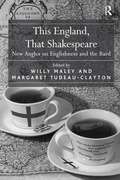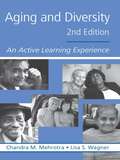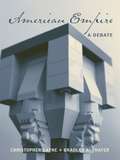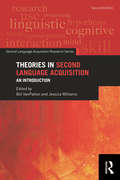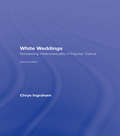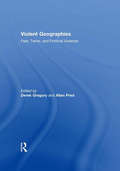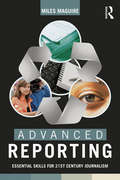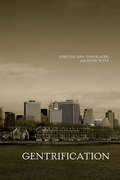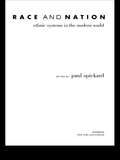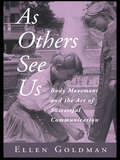- Table View
- List View
This England, That Shakespeare: New Angles On Englishness And The Bard (PDF)
by Willy Maley Margaret Tudeau-ClaytonIs Shakespeare English, British, neither or both? Addressing from various angles the relation of the figure of the national poet/dramatist to constructions of England and Englishness this collection of essays probes the complex issues raised by this question, first through explorations of his plays, principally though not exclusively the histories (Part One), then through discussion of a range of subsequent appropriations and reorientations of Shakespeare and 'his' England (Part Two). If Shakespeare has been taken to stand for Britain as well as England, as if the two were interchangeable, this double identity has come under increasing strain with the break-up - or shake-up - of Britain through devolution and the end of Empire. Essays in Part One examine how the fissure between English and British identities is probed in Shakespeare's own work, which straddles a vital juncture when an England newly independent from Rome was negotiating its place as part of an emerging British state and empire. Essays in Part Two then explore the vexed relations of 'Shakespeare' to constructions of authorial identity as well as national, class, gender and ethnic identities. At this crucial historical moment, between the restless interrogations of the tercentenary celebrations of the Union of Scotland and England in 2007 and the quatercentenary celebrations of the death of the bard in 2016, amid an increasing clamour for a separate English parliament, when the end of Britain is being foretold and when flags and feelings are running high, this collection has a topicality that makes it of interest not only to students and scholars of Shakespeare studies and Renaissance literature, but to readers inside and outside the academy interested in the drama of national identities in a time of transition.
Social Sciences: The Big Issues
by Kath WoodwardThe social sciences are about people and the relationships between individuals and the social and material world we live in. They are about the social structures which shape – and are shaped by – social forces such as ethnicity, race, gender, sexuality and age and the bodies we inhabit. How are these relationships changing and to what extent and how can people influence change? What are the big issues which concern us today? How can the social sciences help us to understand what is going on? Social Sciences: The Big Issues third edition looks at what matters in terms of what is changing and what remains the same in contemporary life, bringing together personal concerns and social forces. Fully revised and updated, this book explores some of the debates about how we live our personal, domestic and emotional lives at a time of change and disruption, including economic crises and uncertainties. The issues covered include: changing selves and personal lives; the role of consumption and consumerism; materialism and material culture; as well as citizenship, migration and globalization as both opportunities and sources of inequality in the contemporary world and in everyday lives. The third edition of Social Sciences: The Big Issues provides a clear, accessible introduction to the ideas and approaches of the social sciences across a range of disciplines, including sociology, psychology and politics.
Service Work: Critical Perspectives
by Marek Korczynski Cameron MacDonaldEveryday, we are bombarded with advertising images of the smiling service worker. The book is written with the aim of focusing beneath the surface of these fairy tale images, to seek out and understand the reality of service workers’ experience. Within the sociology of work and related literatures, there are an increasing number of empirical studies of different types of service work, but there has been little progress in attempts to theorize the nature of service work, per se. This book fills this gap by bringing together major scholars from the US and UK who use a range of critical perspectives to explore key elements in the organization and experience of contemporary service work. It will make an invaluable secondary text for advanced undergraduates and graduates studying courses/modules such as sociology of work, industrial sociology, social theory and work, organization studies, and organizational theory.
Social Sciences: The Big Issues
by Kath WoodwardThe social sciences are about people and the relationships between individuals and the social and material world we live in. They are about the social structures which shape – and are shaped by – social forces such as ethnicity, race, gender, sexuality and age and the bodies we inhabit. How are these relationships changing and to what extent and how can people influence change? What are the big issues which concern us today? How can the social sciences help us to understand what is going on? Social Sciences: The Big Issues third edition looks at what matters in terms of what is changing and what remains the same in contemporary life, bringing together personal concerns and social forces. Fully revised and updated, this book explores some of the debates about how we live our personal, domestic and emotional lives at a time of change and disruption, including economic crises and uncertainties. The issues covered include: changing selves and personal lives; the role of consumption and consumerism; materialism and material culture; as well as citizenship, migration and globalization as both opportunities and sources of inequality in the contemporary world and in everyday lives. The third edition of Social Sciences: The Big Issues provides a clear, accessible introduction to the ideas and approaches of the social sciences across a range of disciplines, including sociology, psychology and politics.
Instructional Strategies for Middle and High School
by Bruce E. Larson Timothy A. KeiperInstructional Strategies for Middle and High School is an accessible, practical, and engaging methods textbook that introduces pre-service teachers to various instructional strategies and helps them to decide how and when to use these methods in the classroom. Classrooms are comprised of diverse learners, and aspiring teachers will face complex decisions about the assessment of student learning and classroom management. Instructional Strategies for Middle and High School equips pre-service teachers with the methodological tools to promote understanding, conceptual awareness, and learning for every child in the classroom. Features include: clear, step-by-step descriptions of seven instructional techniques that pre-service teachers can realistically implement within the classroom setting practical suggestions for ways to integrate effective classroom management and valid assessment techniques with each instructional strategy concrete examples to illustrate each concept or teaching method described guidelines for deciding which instructional methods are most appropriate to different classroom situations and for diverse learners guides for creating lesson plans access to a comprehensive companion website that provides additional resources and further ways to engage with the material presented in the chapters. http://www.routledge.com/textbooks/instructionalstrategies
Instructional Strategies for Middle and High School
by Bruce E. Larson Timothy A. KeiperInstructional Strategies for Middle and High School is an accessible, practical, and engaging methods textbook that introduces pre-service teachers to various instructional strategies and helps them to decide how and when to use these methods in the classroom. Classrooms are comprised of diverse learners, and aspiring teachers will face complex decisions about the assessment of student learning and classroom management. Instructional Strategies for Middle and High School equips pre-service teachers with the methodological tools to promote understanding, conceptual awareness, and learning for every child in the classroom. Features include: clear, step-by-step descriptions of seven instructional techniques that pre-service teachers can realistically implement within the classroom setting practical suggestions for ways to integrate effective classroom management and valid assessment techniques with each instructional strategy concrete examples to illustrate each concept or teaching method described guidelines for deciding which instructional methods are most appropriate to different classroom situations and for diverse learners guides for creating lesson plans access to a comprehensive companion website that provides additional resources and further ways to engage with the material presented in the chapters. http://www.routledge.com/textbooks/instructionalstrategies
The Diaspora Strikes Back: Caribeño Tales of Learning and Turning (Cultural Spaces)
by Juan FloresIn The Diaspora Strikes Back the eminent ethnic and cultural studies scholar Juan Flores flips the process on its head: what happens to the home country when it is being constantly fed by emigrants returning from abroad? He looks at how 'Nuyoricans' (Puerto Rican New Yorkers) have transformed the home country, introducing hip hop and modern New York culture to the Caribbean island. While he focuses on New York and Mayaguez (in Puerto Rico), the model is broadly applicable. Indians introducing contemporary British culture to India; New York Dominicans bringing slices of New York culture back to the Dominican Republic; Mexicans bringing LA culture (from fast food to heavy metal) back to Guadalajara and Monterrey. This ongoing process is both massive and global, and Flores' novel account will command a significant audience across disciplines.
Re-Envisioning Global Development: A Horizontal Perspective
by Sandra HalperinRe-Envisioning Global Development offers an original conceptualisation of capitalist development from its origins to the present day. Most approaches to understanding contemporary development assume that industrial capitalism was achieved through a process of nationally organised economic growth, and that in recent years its organisation has become increasingly trans-local or global. However, Halperin shows that nationally organised economic growth has rarely been the case – it has only recently come to characterise a few countries and for only a few decades. This innovative text elaborates an alternative ontology and way of thinking about global development during the last two centuries – one linked, not to nations and regions, but to a set of essentially trans-national relations and connections. It argues that capitalist development has, everywhere and from the start, involved—not whole nations or societies–but only sectors or geographical areas within states. By bringing this aspect of historically ‘normal’ capitalist development into clearer focus, the book clarifies the specific conditions and circumstances that enabled European economies to pursue a more broad-based development following World War II, and what prevented a similar outcome in the contemporary ‘third world’. It also clarifies the nature, spatial extent, and circumstances of current globalising trends. Wide-ranging and provocative, this book is required reading for advanced level students and scholars in development studies, development economics and political science.
Re-Envisioning Global Development: A Horizontal Perspective
by Sandra HalperinRe-Envisioning Global Development offers an original conceptualisation of capitalist development from its origins to the present day. Most approaches to understanding contemporary development assume that industrial capitalism was achieved through a process of nationally organised economic growth, and that in recent years its organisation has become increasingly trans-local or global. However, Halperin shows that nationally organised economic growth has rarely been the case – it has only recently come to characterise a few countries and for only a few decades. This innovative text elaborates an alternative ontology and way of thinking about global development during the last two centuries – one linked, not to nations and regions, but to a set of essentially trans-national relations and connections. It argues that capitalist development has, everywhere and from the start, involved—not whole nations or societies–but only sectors or geographical areas within states. By bringing this aspect of historically ‘normal’ capitalist development into clearer focus, the book clarifies the specific conditions and circumstances that enabled European economies to pursue a more broad-based development following World War II, and what prevented a similar outcome in the contemporary ‘third world’. It also clarifies the nature, spatial extent, and circumstances of current globalising trends. Wide-ranging and provocative, this book is required reading for advanced level students and scholars in development studies, development economics and political science.
Aging and Diversity: An Active Learning Experience
by Chandra M. Mehrotra Lisa S. Wagner Stephen FriedThis new edition has been completely rewritten and includes chapters that address key topics in diversity and aging: research methods, psychological aging; health beliefs, behaviors, and services; health disparities; informal and formal care for older persons; work and retirement; religious affiliation and spirituality; and death, dying, and bereavement. Taking a broad view of diversity, Mehrotra and Wagner discuss elements of diversity such as gender, race or ethnicity, religious affiliation, social class, rural-urban community location and sexual orientation. Including these elements allows them to convey some of the rich complexities of our diverse culture - complexities that provide both challenges to meet the needs of diverse population and opportunities to learn how to live in a pluralistic society. Throughout the book, Mehrotra and Wagner present up-to-date knowledge and scholarship in a way that engages readers in active learning. Rather than simply transmitting information, the authors place ongoing emphasis on developing readers’ knowledge and skills; fostering higher order thinking and encouraging exploration of personal values and attitudes. Distinctive features of the book include: Opening vignettes for each chapter that present a sampling of how the issues to be discussed apply to diverse elders. Active learning experiences that invite readers to interview diverse elders, conduct internet searches, and give an analysis of a case study. Quizzes at the end of the chapters help readers ascertain the extent to which they have learned the material; the key for each quiz includes details about correct and incorrect responses so that additional learning can occur. Aging and Diversity Online boxes interspersed throughout the book provide internet resources that readers may use to find new research and publications. Suggested readings and audiovisual resources given at the end of each chapter serve as a guide to additional information on topics covered in the chapter. This approach of presenting the material will help the readers understand and apply key concepts and principles in ways that will not only improve the lives of older people they serve, but will also enhance their own aging experience.
Aging and Diversity: An Active Learning Experience
by Chandra M. Mehrotra Lisa S. Wagner Stephen FriedThis new edition has been completely rewritten and includes chapters that address key topics in diversity and aging: research methods, psychological aging; health beliefs, behaviors, and services; health disparities; informal and formal care for older persons; work and retirement; religious affiliation and spirituality; and death, dying, and bereavement. Taking a broad view of diversity, Mehrotra and Wagner discuss elements of diversity such as gender, race or ethnicity, religious affiliation, social class, rural-urban community location and sexual orientation. Including these elements allows them to convey some of the rich complexities of our diverse culture - complexities that provide both challenges to meet the needs of diverse population and opportunities to learn how to live in a pluralistic society. Throughout the book, Mehrotra and Wagner present up-to-date knowledge and scholarship in a way that engages readers in active learning. Rather than simply transmitting information, the authors place ongoing emphasis on developing readers’ knowledge and skills; fostering higher order thinking and encouraging exploration of personal values and attitudes. Distinctive features of the book include: Opening vignettes for each chapter that present a sampling of how the issues to be discussed apply to diverse elders. Active learning experiences that invite readers to interview diverse elders, conduct internet searches, and give an analysis of a case study. Quizzes at the end of the chapters help readers ascertain the extent to which they have learned the material; the key for each quiz includes details about correct and incorrect responses so that additional learning can occur. Aging and Diversity Online boxes interspersed throughout the book provide internet resources that readers may use to find new research and publications. Suggested readings and audiovisual resources given at the end of each chapter serve as a guide to additional information on topics covered in the chapter. This approach of presenting the material will help the readers understand and apply key concepts and principles in ways that will not only improve the lives of older people they serve, but will also enhance their own aging experience.
American Empire: A Debate
by Christopher Layne Bradley A. ThayerIn this short, accessible book Layne and Thayer argue the merits and demerits of an American empire. With few, if any, rivals to its supremacy, the United States has made an explicit commitment to maintaining and advancing its primacy in the world. But what exactly are the benefits of American hegemony and what are the costs and drawbacks for this fledgling empire? After making their best cases for and against an American empire, subsequent chapters allow both authors to respond to the major arguments presented by their opponents and present their own counter arguments.
American Empire: A Debate
by Christopher Layne Bradley A. ThayerIn this short, accessible book Layne and Thayer argue the merits and demerits of an American empire. With few, if any, rivals to its supremacy, the United States has made an explicit commitment to maintaining and advancing its primacy in the world. But what exactly are the benefits of American hegemony and what are the costs and drawbacks for this fledgling empire? After making their best cases for and against an American empire, subsequent chapters allow both authors to respond to the major arguments presented by their opponents and present their own counter arguments.
Theories in Second Language Acquisition: An Introduction
by Bill VanPatten Jessica WilliamsThe second edition of Theories in Second Language Acquisition seeks to build on the strengths of the first edition by surveying the major theories currently used in second language acquisition research. This volume is an ideal introductory text for undergraduate and graduate students in SLA and language teaching. Each chapter focuses on a single theory, written by a leading scholar in the field in an easy-to-follow style – a basic foundational description of the theory, relevant data or research models used with this theory, common misunderstandings, and a sample study from the field to show the theory in practice. This text is designed to provide a consistent and coherent presentation for those new to the field who seek basic understanding of theories that underlie contemporary SLA research. Researchers will also find the book useful as a "quick guide" to theoretical work outside their respective domains.
White Weddings: Romancing Heterosexuality in Popular Culture
by Chrys IngrahamThis is a groundbreaking study of our culture's obsession with weddings. By examining popular films, commercials, magazines, advertising, television sitcoms and even children's toys, this book shows the pervasive influence of weddings in our culture and the important role they play in maintaining the romance of heterosexuality, the myth of white supremacy and the insatiable appetite of consumer capitalism. It examines how the economics and marketing of weddings have replaced the religious and moral view of marriage. This second edition includes many new and updated features including: full coverage of the wedding industrial complex; gay marriage and its relationship to white weddings and heterosexuality and demographics shifts as to who is marrying whom and why, nationally and internationally.
White Weddings: Romancing Heterosexuality in Popular Culture
by Chrys IngrahamThis is a groundbreaking study of our culture's obsession with weddings. By examining popular films, commercials, magazines, advertising, television sitcoms and even children's toys, this book shows the pervasive influence of weddings in our culture and the important role they play in maintaining the romance of heterosexuality, the myth of white supremacy and the insatiable appetite of consumer capitalism. It examines how the economics and marketing of weddings have replaced the religious and moral view of marriage. This second edition includes many new and updated features including: full coverage of the wedding industrial complex; gay marriage and its relationship to white weddings and heterosexuality and demographics shifts as to who is marrying whom and why, nationally and internationally.
Theories in Second Language Acquisition: An Introduction
by Bill VanPatten Jessica WilliamsThe second edition of Theories in Second Language Acquisition seeks to build on the strengths of the first edition by surveying the major theories currently used in second language acquisition research. This volume is an ideal introductory text for undergraduate and graduate students in SLA and language teaching. Each chapter focuses on a single theory, written by a leading scholar in the field in an easy-to-follow style – a basic foundational description of the theory, relevant data or research models used with this theory, common misunderstandings, and a sample study from the field to show the theory in practice. This text is designed to provide a consistent and coherent presentation for those new to the field who seek basic understanding of theories that underlie contemporary SLA research. Researchers will also find the book useful as a "quick guide" to theoretical work outside their respective domains.
Violent Geographies: Fear, Terror, and Political Violence
by Derek Gregory Allan Pred"Violent Geographies is essential to understanding how the politics of fear, terror, and violence in being largely hidden geographically can only be exposed in like manner. The 'War on Terror' finally receives the coolly critical analysis its ritual invocation has long required." —John Agnew, Professor of Geography, UCLA "Urgent, passionate and deeply humane, Violent Geographies is uncomfortable but utterly compelling reading. An essential guide to a world splintered and wounded by fear and aggression—this is geography at its most politically engaged, historically sensitive, and intellectually brave." —Ben Highmore, University of Sussex "This is what a ‘public geography’ should be all about: acute analysis of momentous issues of our time in an accessible language. Gregory and Pred have assembled a peerless group of critical geographers whose essays alter conventional understandings of terror, violence, and fear. No mere gazetteer, Violent Geographies shows how place, space and landscape are central components of the real and imagined practices that constitute organised violence past and present. If you thought terror, violence, and fear were the professional preserve of security analysts and foreign affairs experts this book will force you to think again." —Noel Castree, School of Environment and Development, Manchester University "A studied, passionate and moving examination of the way in which the violent logics of the ‘War on Terror’ have so quickly shuttered and reorganized the spaces of this planet on its different scales. From the book emerges a critical new cartography that clearly charts an archipelago of a large multiplicity of ‘wild’ and ‘tamed’ places as well as ‘black holes’ within and between which we all struggle to live."—Eyal Weizman, Director, Goldsmiths College Centre for Research Architecture
Violent Geographies: Fear, Terror, and Political Violence
by Derek Gregory Allan Pred"Violent Geographies is essential to understanding how the politics of fear, terror, and violence in being largely hidden geographically can only be exposed in like manner. The 'War on Terror' finally receives the coolly critical analysis its ritual invocation has long required." —John Agnew, Professor of Geography, UCLA "Urgent, passionate and deeply humane, Violent Geographies is uncomfortable but utterly compelling reading. An essential guide to a world splintered and wounded by fear and aggression—this is geography at its most politically engaged, historically sensitive, and intellectually brave." —Ben Highmore, University of Sussex "This is what a ‘public geography’ should be all about: acute analysis of momentous issues of our time in an accessible language. Gregory and Pred have assembled a peerless group of critical geographers whose essays alter conventional understandings of terror, violence, and fear. No mere gazetteer, Violent Geographies shows how place, space and landscape are central components of the real and imagined practices that constitute organised violence past and present. If you thought terror, violence, and fear were the professional preserve of security analysts and foreign affairs experts this book will force you to think again." —Noel Castree, School of Environment and Development, Manchester University "A studied, passionate and moving examination of the way in which the violent logics of the ‘War on Terror’ have so quickly shuttered and reorganized the spaces of this planet on its different scales. From the book emerges a critical new cartography that clearly charts an archipelago of a large multiplicity of ‘wild’ and ‘tamed’ places as well as ‘black holes’ within and between which we all struggle to live."—Eyal Weizman, Director, Goldsmiths College Centre for Research Architecture
Advanced Reporting: Essential Skills for 21st Century Journalism
by Miles MaguireNews gathering is a large, complicated and often messy task that has traditionally been viewed by journalists as irretrievably idiosyncratic, best learned through trial and error. Advanced Reporting takes the opposite approach, focusing on reporting as a process of triangulation based on three essential activities: analyzing documents, making observations and conducting interviews. In this readable book, veteran journalism professor Miles Maguire shows how the best reporters use these three tools in a way that allows them to cross-check and authenticate facts, to reduce or eliminate unsupportable allegations and to take readers and viewers to a deeper level of insight and understanding. This book will help to prepare students for a profession marked by increasing complexity and competition. To succeed in this environment, journalists must learn to make the most of digital media to intensify the impact of their work. At the same time, reporters must contend with a host of sophisticated public relations techniques while engaging with news audiences that no longer just consume journalism, but also collaborate in its creation. Discussion questions and exercises help students put theory into practice.
Advanced Reporting: Essential Skills for 21st Century Journalism
by Miles MaguireNews gathering is a large, complicated and often messy task that has traditionally been viewed by journalists as irretrievably idiosyncratic, best learned through trial and error. Advanced Reporting takes the opposite approach, focusing on reporting as a process of triangulation based on three essential activities: analyzing documents, making observations and conducting interviews. In this readable book, veteran journalism professor Miles Maguire shows how the best reporters use these three tools in a way that allows them to cross-check and authenticate facts, to reduce or eliminate unsupportable allegations and to take readers and viewers to a deeper level of insight and understanding. This book will help to prepare students for a profession marked by increasing complexity and competition. To succeed in this environment, journalists must learn to make the most of digital media to intensify the impact of their work. At the same time, reporters must contend with a host of sophisticated public relations techniques while engaging with news audiences that no longer just consume journalism, but also collaborate in its creation. Discussion questions and exercises help students put theory into practice.
Gentrification
by Loretta Lees Tom Slater Elvin WylyThis first textbook on the topic of gentrification is written for upper-level undergraduates in geography, sociology, and planning. The gentrification of urban areas has accelerated across the globe to become a central engine of urban development, and it is a topic that has attracted a great deal of interest in both academia and the popular press. Gentrification presents major theoretical ideas and concepts with case studies, and summaries of the ideas in the book as well as offering ideas for future research.
Gentrification
by Loretta Lees Tom Slater Elvin WylyThis first textbook on the topic of gentrification is written for upper-level undergraduates in geography, sociology, and planning. The gentrification of urban areas has accelerated across the globe to become a central engine of urban development, and it is a topic that has attracted a great deal of interest in both academia and the popular press. Gentrification presents major theoretical ideas and concepts with case studies, and summaries of the ideas in the book as well as offering ideas for future research.
Race and Nation: Ethnic Systems in the Modern World
by Paul SpickardRace and Nation is the first book to compare the racial and ethnic systems that have developed around the world. It is the creation of nineteen scholars who are experts on locations as far-flung as China, Jamaica, Eritrea, Brazil, Germany, Punjab, and South Africa. The contributing historians, sociologists, anthropologists, political scientists, and scholars of literary and cultural studies have engaged in an ongoing conversation, honing a common set of questions that dig to the heart of racial and ethnic groups and systems.Guided by those questions, they have created the first book that explores the similarities, differences, and the relationships among the ways that race and ethnicity have worked in the modern world. In so doing they have created a model for how to write world history that is detailed in its expertise, yet also manages broad comparisons.
As Others See Us: Body Movement and the Art of Successful Communication
by Ellen GoldmanAs Others See Us, first published in 1994 by Gordon & Breach, is a book designed to introduce the reader to a new way of thinking about the movements, both conscious and unconscious, that we make every day and every second of our lives. Goldman describes the human experience as a continuous stream of body movements, though we are only aware of a small fraction of the more obvious and intrusive physical acts. The aim of this book is first to increase awareness of the subtleties and complexities of our body language, and then to encourage the reader to perceive these intricacies in their own movements and in those of others. Finally, with a more complete understanding and appreciation for the power of body language and non-verbal communication, one can achieve a deeper connection between physical and intellectual spheres, to allow for a fuller and more engaging experience of communication and expression. This new knowledge of the human body's movements not only permits one to more accurately perceive the emotions and thoughts of others, but can allow a glimpse into one's own mind, to see how we present ourselves to the world, and whether our thoughts are in sync with our actions. Central to the text is the author's treatment of the Integrated Movement, a term used to describe the merger of a posture and a gesture with a consistent quality, dynamic or shape. This approach to understanding and explaining human movement offers a unique way of thinking about conscious gesture, unconscious body language, and verbal speech as interconnected communication, a synthesis that allows for a more complete view of ourselves and others around us. The structure of the book follows a logical framework that mirrors the progress of the reader, from perception of movement, to the close inspection of gesture and body language, to the introduction and experience of Integrated Movement, to the application of one's new awareness to different aspects of life. Biographical sketches of leading figures in the field are included, as are suggestions for additional reading and resources. Perhaps the most unique feature of the book are the personal exercises (boxed-off text) that appear on almost every other page. These exercises are designed to allow the reader to experience the power of body language in real-life situations, while working towards the increased awareness and perception that is the goal of the book.
